These Travelers Insist That the Best Way to See the World is on a Horse
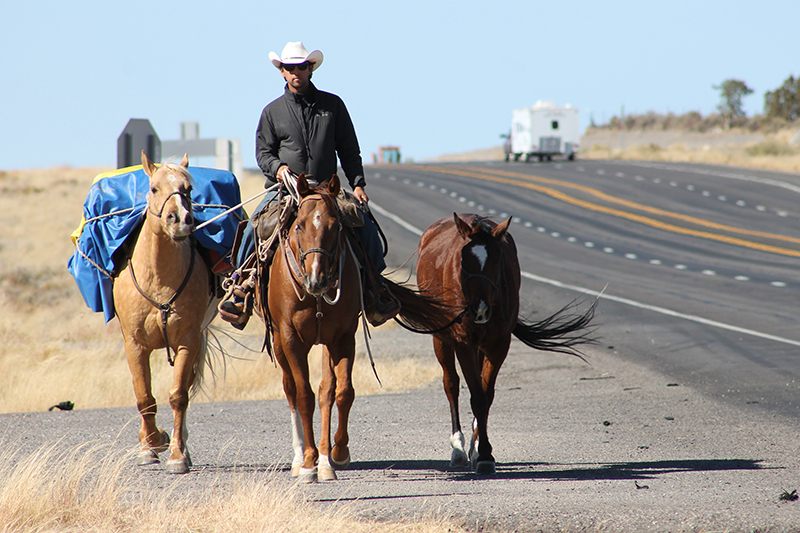
Filipe Masetti Leite rides through New Mexico. (Photo: Filipe Masetti Leite)
The biggest problem was the weather.
“It was super hot, no shade on the road,” says Filipe Leite. “I thought I was going to die on the side of that road. Then we got snow in Texas and the cold in southern U.S., which makes it so hard to ride. Your knees ache a lot.”

Leite’s tale could be lifted straight from the memoir of an Old West explorer, but his journey began in 2012 when he departed from Canada’s legendary rodeo, the Calgary Stampede, and began to make his way to Brazil with two horses. He traveled for 803 days, through 10 different countries and three continents. His journey included the hardships of long-trekking predecessors, but with modern trappings: careless drivers, border bureaucracy and video dispatches. Leite is a member of The Long Riders’ Guild—an elite club of people all over the world who have traveled more than 1,000 miles by horse on one journey. (Although many long riders travel much further—logging tens of thousands of miles on horseback.)

Filipe Masetti Leite rides through southern Texas with the Davis mountains serving as backdrop. (Photo: Filipe Masetti Leite)
The Geneva-based Guild was founded in 1994 by CuChullaine O’Reilly, a horse trekker who has made epic journeys across Pakistan and Afghanistan. Membership is invitation only and extended to riders who have completed a 1,000 mile or longer trek, adhering to guidelines set forth by the Guild that include such stipulations as “a determination to put the horse’s welfare above their own” and the warning that anyone “paying money to be led is a tourist on a trail ride not a Long Rider”. There are no dues or meetings; the club is a hub of information and support. Its website sternly cautions that upon admittance, members shouldn’t expect to be “awarded a silver trophy, a blue ribbon or a shiny big belt buckle from the Guild.” Respect is the prize.
Long rides are, by design, unique affairs. There’s no standard trip. Many undertake their journey with more than one horse—riding one while others carry essentials in saddle packs is common. Some will assign horses different roles (a riding horse and a pack horse), others rotate the jobs. Some ride many horses, buying, selling, or trading animals as they go. Occasionally vehicles accompany them, although this tactic is used sparingly, according to the Guild’s guidelines.
Riders will travel for hours, with breaks for the horses that can last days. Riders often camp; showers are a luxury. Some pay for their travels themselves, others accrue sponsors. These horse travelers have diverse backgrounds—Leite, whose father was a horseman and cowboy, says he was on the back of a horse before he could walk. But others grew up with passing experience or none at all.

Filipe Masetti Leite rides through the Chihuahua Desert during a sand storm. (Photo: Filipe Masetti Leite)
Australian Kimberly Delavere was working as an apprentice at a bakery and hating it. She made a deal with herself: If she quit, she would justify it by doing something “awesome”. Ever since she was a child she had felt the tug of the Bicentennial National Trail—a rugged trek that extends over 3,300 miles across remote bush and mountains. The first time Delavere locked eyes on it she thought, “I’m going to do that trail with horses.”There was one small catch: She had just a casual relationship with riding. So she packed up her life and moved to Beechwood to be near a horse breeder friend, contacted the Guild and started networking with experienced equestrians.
“All I did was work all year, and if I did anything that wasn’t really about the trip I felt guilty,” says Delavere. “I bought two new shirts all year.”
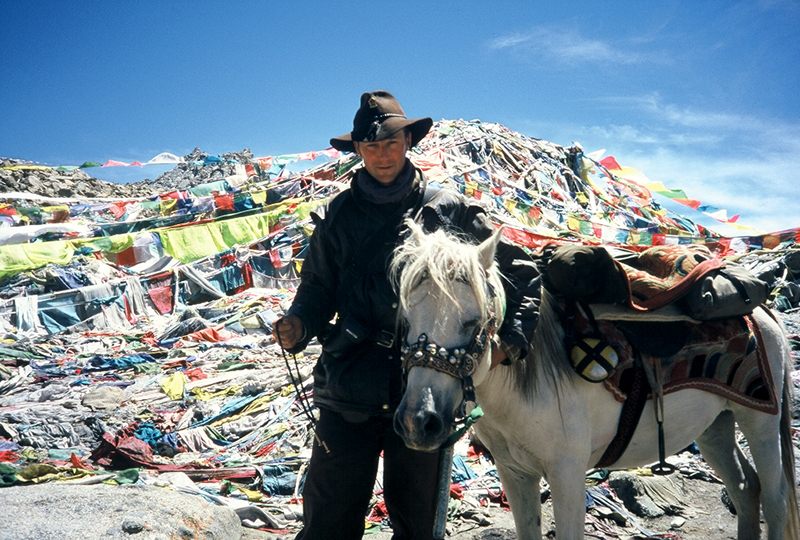
Ian Robinson at Dolma la pass, Mt Kailas, Tibet, in 2004, with his horse Monlam. (Photo: Ian Robinson)
In December, Delavere, 24, embarked on the first leg of her ride with her riding horse, Clem (“pretty much the boss”) and her pack horse, Pippin (“she’d go until she’d die”). (Delavere had been on the trail for a day when she spoke to Atlas Obscura.) She has devoted around a year to complete the trip, but is prepared to take longer—she’ll take breaks to work and save up money en route if she has to.
She laughed describing the pack saddle she ordered from the United States.
“I had no idea how to put it together! Nothing comes with instructions,” she says. (Her arsenal now includes her lightweight camping gear, food, a spartan wardrobe, maps and a compass, a portable electric fence for the horses, a satellite beacon that can summon help in emergencies and five books including On the Trail of Genghis Kahn by Tim Cope and About a Boy by Nick Hornsby.)
Like any prolonged encounter with nature, long riding comes with its dangers. Already, for instance, at the time of writing, Delavere has already seen three snakes on the trail. She futher runs the risk of bumping into wild horses, pigs, dogs, wolves, crocodiles and bush fires.
And that’s just the start of a laundry list of possible problems—long riders contend with horse thieves, wild animals, bad weather, poisonous plants, traffic, rough terrain and getting lost. But perhaps one of the most pernicious evils Leite faced on his journey from Canada to Brazil was of human design.
“The bureaucracy of crossing borders with three horses was just unbearable,” says Leite. “It makes you want to shoot yourself in the head.”

Bonnie Folkins riding with nomads in Mongolia. (Photo: Bonnie Folkins)
Leite was stopped at the border of Panama, an ordeal that ended up lasting three months and ending in a $30,000 plane ride for his horses, Bruiser, Frenchie and Dude. Altogether, Leite estimates his excursion cost around $120,000, much of which was paid for by a deal to chronicle his trip for production company Out Wild TV.
Solitude also waits on the trail. In 1992, New Zealander Ian Robinson rode a total of 14 horses 1,677 miles across Mongolia. In later years he rode through Tibet and Afghanistan. On that first trip, he was ill-prepared.
“Looking back now, I thought ‘Oh my God, that was fucking nuts’, you know?,” he says. “But at the time I didn’t quite know what I was getting myself in for. So there was kind of the courage of fools, if you want to call it that.”
He didn’t have a flashlight; he had never fished a horse out of a muddy bog before, but it was the mental struggle that surprised him.
“I think the thing I learned in Mongolia was the challenge of solitude, of spending months at a time without meeting anybody who could speak my language,” says Robinson.
Long riders call this “the long quiet”—something Canadian Bonnie Folkins came to know well during journeys through Mongolia and Kazakhstan, where she photographed eagle hunters, endured landscapes ravaged by desertification and was beset with fleas, which she successfully banished with hair dye. (“Just because you’re riding and you have fleas doesn’t mean you don’t have to look good.”)
Viewing the universe above the vast Mongolian plains and desert from the back of a horse was “so profound it was as if I was traveling in outer space.”
Upon returning to her home in Canada the sound of telephones ringing unsettled her. She couldn’t stand being in busy stores. It took her two months to re-acclimate.
Occasionally, horses and riders do not make it home. In 2013, rider Christine Henchie was struck and killed by a bus during her ride through Africa. The Guild’s website includes a memorial section for horses that succumbed to falling off cliffs, carnivorous flies, poisonous snakes, and other calamities. Riders must be prepared to “basically be a vet”, says Leite. One of his horses was struck by a truck; Leite treated him and he recovered. (His horses are now retired on his family ranch in Brazil where they “they just eat grass, drink water and poo all day.”)
“The constant concern is your horse,” says Robinson. “Before yourself, you’re thinking about your horse. You think about your horse all the time. There’s no horse, there’s no ride.”
So why suffer the danger, discomfort and isolation?
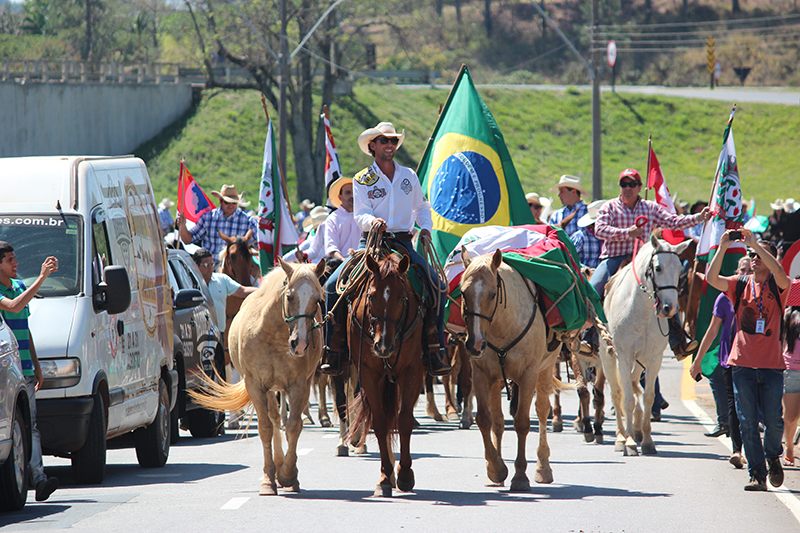
After 803 days on the road, Filipe Masetti Leite rides into his hometown of Espirito Santo do Pinhal, Sao Paulo, where his journey ended. (Photo: Filipe Masetti Leite)
“You’re not connected to a road,” says Robinson. “You can go anywhere you like. Even the best four wheel drive is not going to get you there, you don’t even need a trail or anything. Your horse will carry you anywhere.”
Leite says that he, like many riders, worry that the tradition of horse travel is fading and was encouraged by those he met on the road who were captivated by his mission and gave him food and shelter, among other things.
“I was given a woman’s ashes in Colorado,” says Leite. “I was given a horse in New Mexico, a dog in Brazil.”
Folkins reflected on the long quiet when asked why she kept going.
“It doesn’t take a great deal of bravery, really,” she says. “It takes considerable stamina and I think it takes stick-to-itivness, and then you get these strange rewards. You get in this mindplace you didn’t expect. And it happens to anybody; every long rider. You come out thinking, ‘Oh my God, what happened?’”



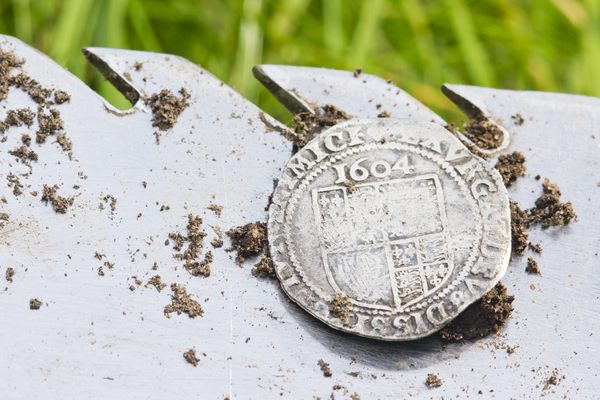



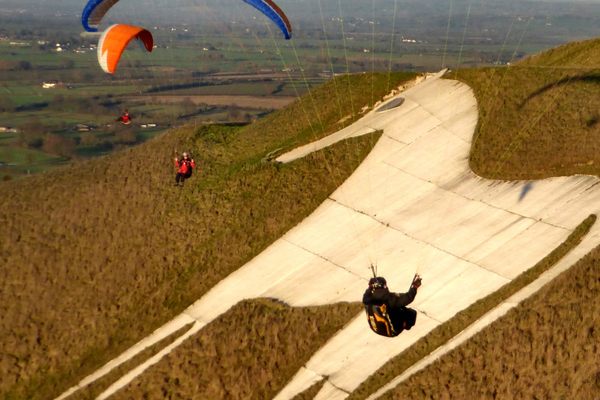

Follow us on Twitter to get the latest on the world's hidden wonders.
Like us on Facebook to get the latest on the world's hidden wonders.
Follow us on Twitter Like us on Facebook